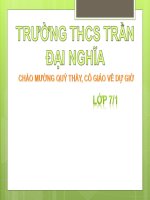Unit 02 Health Lesson 5 Skills 1
Bạn đang xem bản rút gọn của tài liệu. Xem và tải ngay bản đầy đủ của tài liệu tại đây (1.04 MB, 19 trang )
<span class='text_page_counter'>(1)</span>Date. HEALTH. SKILLS 1.
<span class='text_page_counter'>(2)</span> I. VOCABULARY - energy (n). :. Năng lượng. - expert (n). :. Chuyên gia. - diet (n). :. Ăn kiêng. - enough ( adv). :. Đủ. - (to) stay in shape :. Giữ dáng đẹp.
<span class='text_page_counter'>(3)</span> * CHATTING - Do you often play sports or do exercises? - Why are they good for your health?. CALORIES A calorie is energy that helps us do our everyday activities..
<span class='text_page_counter'>(4)</span> II. READING. 1. Match the correct headings with the paragraphs.(Ex 1/ p.22). We need calories or energy to do the things we do every day: walking, riding a bike, and even sleeping! We get calories from the food we eat. If we eat too many, we can get fat. If we don’t eat enough, we feel tired and week.. 1. JUST THE RIGHT AMOUNT. People should have between 1,600 and 2,500 calories a day to stay in shape. Sports and activities like riding a bike and running use a lot of calories. Sleeping and watching TV use less. Do you think you are eating more or less calories than you need?. 2. WHAT IS A CALORIE?. Dr. Dan Law is a diet expert. He knows exactly how much people need to eat, so many people listen to his advice. His calorie tips? Eat less junk food, and count your calories if you’re becoming fat.. 3. AN EXPERT’S VIEW.
<span class='text_page_counter'>(5)</span> 2. Find the following words/ phrases in the text. (Ex. 2 / p.22). 1. DIET. the food that you eat on a daily basis.. someone who has studied a lot about a 2. EXPERT subject or topic and understands it well. 3. TIP. an advice on how to do something quickly and successfully, usually from one’s own experience.. 4. JUNK FOOD 5. STAY IN SHAP. usually convenience food like Mc Donald, KFC … be fit and healthy..
<span class='text_page_counter'>(6)</span> 3. Answer the following questions. (Ex. 3/ p. 22). 1. What is calories? 2. What happens we have too many calories? 3. What is a healthy number of calories per day? 4. Which activity uses a lot of calories? 5. Why do people listen to Dr. Law’s advice?.
<span class='text_page_counter'>(7)</span>
<span class='text_page_counter'>(8)</span> 4. Which activity uses a lot of calories? 1.What is calories? 2.What happens welisten haveto too many calories? 5.Why do people Dr. Law’s 3.What is a healthy number of caloriesadvice? per day? weSports eatthat too many calories get2,500 fat. activities. A calorie isIfenergy helps us do1,600 ourwe everyday To stay healthy you need between and calories. activities and running. Because he is an expert.. 1. 2. 3LN. 4LN. 5. 6LN. 7. 8.
<span class='text_page_counter'>(9)</span> 4. Which activity uses a lot of calories? 1.What is calories? 2.What happens welisten haveto too many calories? 5.Why do people Dr. Law’s 3.What is a healthy number of caloriesadvice? per day? weSports eatthat too many calories get2,500 fat. activities. A calorie isIfenergy helps us do1,600 ourwe everyday To stay healthy you need between and calories. activities and running. Because he is an expert.. 1. 2LN. 3. 4. 5. 6LN. 7 LN. 8.
<span class='text_page_counter'>(10)</span> III. SPEAKING 1. Look at the table and discuss the following questions. (Ex. 4/ p.22). 1. Why do you think some activities use more calories than others. 2. Which activity uses more calories: gardening or walking? 3. How many calories do you use doing aerobics for 2 hours? 4. What do you think happens when we have too few calories, but too many calories?.
<span class='text_page_counter'>(11)</span> 1. Look at the table and discuss the following questions. (Ex. 4/ p.22) Sleeping - 60 ( calories used per hour). Watching TV – 75 ( calories used per hour).
<span class='text_page_counter'>(12)</span> 1. Look at the table and discuss the following questions. (Ex. 4/ p.22) Walking- 230 ( calories used per hour). Which activity uses more energy: gardening or walking? Gardening- 275 ( calories used per hour).
<span class='text_page_counter'>(13)</span> 1. Look at the table and discuss the following questions. (Ex. 4/ p.22) Cycling - 590 ( calories used per hour). Running - 880 ( calories used per hour).
<span class='text_page_counter'>(14)</span> 1. Look at the table and discuss the following questions. (Ex. 4/ p.22) Aerobics - 330 ( calories used per hour). How many calories do you use doing aerobics for 2 hours? Swimming - 460 ( calories used per hour).
<span class='text_page_counter'>(15)</span> 2. Complete the chart about those activities. (Ex. 5 and 6 /p.22). Activity. Number of hours (per day). Total number of calories.
<span class='text_page_counter'>(16)</span> IV. AT HOME Learn new words by heart. Practise the exercises again. Do exercises D1, 2, 3 (page 13, 14 / workbook). Prepare SKILLS 2..
<span class='text_page_counter'>(17)</span>
<span class='text_page_counter'>(18)</span> Bye, bye. See you tomorrow. Bye, bye. The bye bye song See you tomorrow. Bye, bye. See you tomorrow. Bye, bye. Bye, bye.. 18.
<span class='text_page_counter'>(19)</span> 19.
<span class='text_page_counter'>(20)</span>









